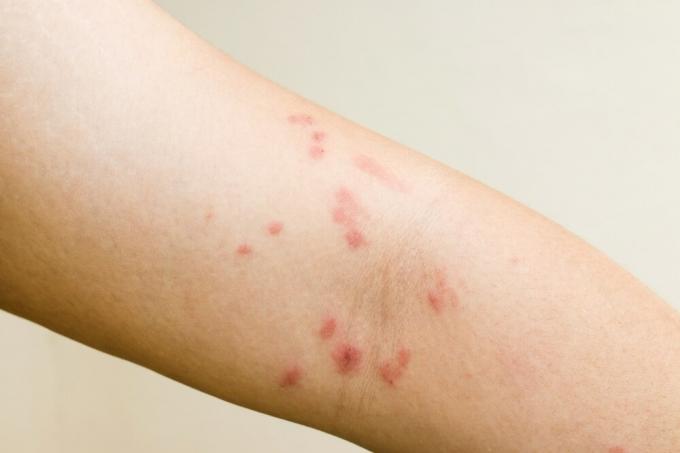
table of contents
- Symptoms in humans
- Bed bug traps from stores
- Homemade traps
- Chemical sprays
- frequently asked Questions
Bed bugs are often an unwelcome souvenir from vacation that cause very itchy bites. Depending on the extent of the infestation, they can be combated with different bed bug traps and sprays that can be combined.
In a nutshell
- Bed bugs are suspected of transmitting various diseases and pose a health risk
- A combination of active and passive bed bug traps gives good results for mild infestations
- Chemical-based spray takes effect quickly in the event of severe infestation
Symptoms in humans
Many holidaymakers come into contact with bed bugs in hotels. Often, however, the bed bug is not perceived as the cause and the blame for the itchy bites is put on other insects. Time and again it is assumed that an infestation is favored by poor hygiene. However, this is not wrong, because with normal hygiene, bed bugs can survive without any problems.
The insects then come into your own house with the clothes in their luggage. Especially when you put your suitcase back on the bed and don't wash your clothes right away. If female specimens get into the house in this way, they can lay up to 200 eggs in their lifetime. After just seven days, the larvae hatch and are already sucking blood.
In humans, an infestation usually manifests itself in severely itchy areas of the skin. Other symptoms from stings:

- Inflammation
- Transmission of dangerous diseases (e. B. Hepatitis)
- Visual disturbances
- dermatitis
Bed bug traps from stores
A common remedy for bed bug infestation are traps. There are different types of traps on the market, some of which are also equipped with attractants.
A popular way to get the mattress free of bugs is to cover it with a tight protective cover. As a result, the bugs sit in the trap in the mattress and gradually die off because they no longer receive any food. The disadvantage, however, is that it does not catch bugs in other areas.
Tip: Such protective covers can also be used to protect luggage, which prevents bed bugs from infecting it. Alternatively, if you suspect an infestation, you can use such a cover to prevent further spread and specifically combat the insects.
Bed bug traps that represent a mechanical barrier are efficient. You place the feet of the bed in these traps and the insects are caught by different elevations when they are already in bed. On the other hand, insects that have hidden in other areas, such as wall cracks, cannot overcome the trap and get into bed. It is important that you remove the insects from the traps regularly and dispose of them in such a way that they can no longer come back into the house.
An effective alternative to purely mechanical traps are chemical attractant bed bug traps. The traps are often provided with an adhesive strip on which the insects stick.
Homemade traps
To catch a bed bug, you don't necessarily have to buy traps from specialist retailers. You can build a trap yourself with simple home remedies.
Tip: It makes sense to combine several traps with each other, which will give you a higher degree of effectiveness in fighting.

Above all, glue traps are easy to make yourself. All you need is a wide strip of double-sided adhesive tape that you wrap around the feet of the bed. The bait in this case is you, because you can catch those insects that climb up and down the bed.
It is a little more difficult to make barrier traps in which the feet can be placed. In this case, the barrier is a very smooth surface that is so rarely found on household items. Conventional bowls or plastic containers are usually not effective and do not represent a barrier for the insects.
One method of building a trap that is completely harmless to human health is to use bean leaves. This is a traditional but very effective trap that originally came from the Balkans. The leaves of the Beans have fine hairs that get caught in one of the bed bugs.
Instructions for using bean leaves:
- pluck off fresh leaves
- Spread leaves on the floor around the bed in the evening
- make sure that the leaves lie flat on the ground
- Collect the leaves and the insects the next morning
- Dispose of leaves safely (preferably burn them)
- Repeat until there are no more bugs
Note: This mechanism is currently the subject of research. Scientists want to develop traps that work by the same mechanism and catch the insects by holding onto them.
Chemical sprays
In the case of a strong infestation, however, the only thing that usually helps is the use of a spray. This often contains the insecticide dichlorodiphenyltrichloroethane or a similar substance. The advantage of the spray is that you can not only treat the mattress, but also corners or areas under the bed that are difficult to access.
However, bed bugs have developed some resistance to some agents. Therefore, if a spray does not have an immediate effect, you should use another agent. The following active ingredients are also available in stores:

- Lambda cyhalothrin
- Bifenthrin
- Carbaryl
frequently asked Questions
When used correctly, there is no danger to the residents, as the agents usually evaporate without leaving any residue. However, it is important that you ventilate the rooms adequately after an application.
As a rule, if used correctly, a large proportion of the insects will be killed. Depending on the means, you may have to carry out another application.
They should be changed every two to three days, as dust in particular reduces the adhesion.


